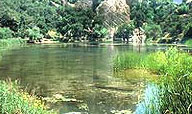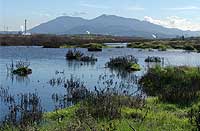Contact EPA Pacific Southwest Water Division
Pacific Southwest, Region 9
Serving: Arizona, California, Hawaii, Nevada, Pacific Islands, Tribal Nations
Monitoring, Assessment and TMDLs
| Monitoring, Assessment and TMDLs Quick Finder | |||
|---|---|---|---|
| Monitoring & TMDLs Home 303(d) lists EPA-established TMDLs | EPA-lead TMDLs: Completed Monitoring Arizona TMDLs | California TMDLs Hawai'i TMDLs Nevada TMDLs | Pacific Islands TMDLs TMDL Contacts |
California Water Quality

On this page:
- Monitoring, Assessment, and Integrated Reporting in California
- Section 303(d) Listing in California
- TMDLs in California
- State-adopted TMDLs in California
- EPA-established TMDLs in California
EPA and California Water Quality Contacts
Water Quality Assessment TMDL Summary Information for California
You will need Adobe Reader to view some of the files on this page. See EPA's PDF page to learn more about PDF, and for a link to the free Adobe Reader.
California's Water Resources Control Board and nine Regional Water Quality Control Boards are responsible for conducting monitoring, assessment, reporting under CWA Sections 303(d) and 305(b), and TMDL development for the State of California. The State Board and Regional Boards cooperate in developing Section 305(b) and Section 303(d) listing reports. TMDLs are normally developed by Regional Boards, and then approved by the State Board and State Office of Administrative Law before being submitted for EPA approval.
Monitoring, Assessment, and Integrated Reporting in California
More information about California's monitoring and assessment programs may be found at State Water Resources Control Board's Water Issues site ![]()
The State Water Resources Control Board also includes a comprehensive range of water quality monitoring and assessment data that can be viewed across space and time: visit My Water Quality for further information. ![]()
Section 303(d) Listing in California
EPA’s Action to Add Waters to California’s 2012 List of Waters Requiring a Total Maximum Daily Load
On June 26, 2015, EPA approved California's 2012 Section 303(d) list of impaired waters in three Regional Water Quality Control Boards (the North Coast, the Lahontan, and the Colorado River Boards) and disapproved the omission of the mercury impairment at Topaz Lake which met the federal listing requirements. EPA provided public notice of its proposed action to place Topaz Lake on California's 303(d) list and provided opportunity for public comment on the proposed addition. The public comment period closed on July 26, 2015 and no comments were received. On July 30, 2015, EPA issued its final decision to add Topaz Lake to the State's 303(d) list. See EPA's final decision letter.
- EPA Partial Approval/Partial Disapproval Letter (PDF) (1 pp, 110K) and Enclosure (PDF) (9 pp, 98K) for California’s 2012 303(d) list.
- EPA's Final Decision Letter for California's 2012 303(d) List (PDF) (1 pp, 332K)
California's 2012 Integrated Report is available at the California State Water Resources Control Board. ![]()
California's 2008-2010 Integrated Report
On November 12, 2010, EPA approved California’s 2008-2010 Section 303(d) list of impaired waters and disapproved the omission of several water bodies and associated pollutants that meet federal listing requirements. EPA identified additional water bodies and pollutants for inclusion on the State’s 303(d) list. EPA provided public notice and the opportunity for public comment on our proposed additions which ended December 23, 2010. On October 11, 2011, EPA issued its final decision regarding the waters EPA added to the State’s 303(d) list. See final transmittal letter with enclosures and responsiveness summary below.
- EPA's partial approval partial disapproval letter and enclosure for California's 2008-2010 list (PDF) (25 pp, 500K)
- EPA’s final decision letter with enclosures and responsiveness summary for California’s 2008-2010 list (PDF) (35 pp, 700K)
California’s 2008-2010 Integrated Report which serves as both their Section 303(d) list and Section 305(b) report is available on their website in report form and as a searchable map. ![]()
Contact Information:
Valentina Cabrera Stagno (cabrera-stagno.valentina@epa.gov)
or Dave Guiliano (guiliano.dave@epa.gov)
U.S. Environmental Protection Agency
75 Hawthorne Street (WTR-2)
San Francisco, CA 94105
(415) 972-3434
Fax (415)947-3537
California's 2004-2006 Integrated Report
On May 29, 2008, EPA revised its previous decision to add microcystin toxins as an additional cause of impairment to one Klamath River segment (Middle Hydrologic Area: Oregon to Iron Gate) previously listed by California in its 2006 Clean Water Act Section 303(d) List. EPA solicited public comment on its action, and has now completed its review of the comments received. Based on comments from the North Coast Regional Board, EPA agreed to revise the description of the segment which EPA is listing as impaired due to “microcystin toxins.” EPA identified this impaired portion as “the reach of the Klamath River including the Copco and Iron Gate Reservoirs.” Accordingly, this segment does not include Klamath River upstream of Copco I Reservoir to Oregon.
- EPA’s May 2008 revised decision for microcystin toxins in Klamath River (PDF) (8 pp, 548K)
- EPA’s responsiveness summary (PDF) (1 pg, 51K)
On March 13, 2008, EPA reconsidered its prior approval of the omission of microcystin toxins listings for three Klamath River segments, and determined to add a listing for microcystin toxin for one of these three segments, “Klamath River HU, Middle HA, Oregon to Iron Gate”. California’s 2006 Section 303(d) List already identifies each segment of the Klamath River within California as impaired due to Nutrients, Organic Enrichment/Low Dissolved Oxygen, and Temperature. EPA’s reconsideration of its decisions related to microcystin toxins and the Klamath River, and its determination to add a listing for microcystin toxins for one of the river’s segments, do not affect EPA’s determinations regarding any other portion of California’s Section 303(d) List. Neither EPA’s approval of the State’s listings for the Klamath River listings, nor EPA’s determination to add the listing for microcystin toxins, extends to any water bodies located within Indian country, as defined in 18 U.S.C. 1151.
- EPA’s March 2008 decision document for microcystin toxins in Klamath River (PDF) (14 pp, 117K)
On Nov. 30, 2006, EPA partially approved California's 2004-2006 303(d) list submission. In summary, this action approved the State's list of impaired waters. On March 8, 2007, EPA partially disapproved California's 2004-2006 303(d) List; that is, we disapproved the State's omission of impaired waters that met federal listing regulations or guidance. EPA identified 36 additional waters bodies and associated pollutants for 34 waters to be added to the State's 303(d) list. EPA provided public notice and the opportunity for public comment on our proposed additions which ended April 16, 2007.
On June 28, 2007, EPA issued its final decision regarding the waters EPA added to the State’s List. See final transmittal letter with enclosures and responsiveness summary below.
- EPA's partial approval letter and enclosure for California's 2004-2006 list (PDF). (9 pp, 58K)
- EPA's partial disapproval letter and enclosures (PDF) for California's 2004-2006 303(d) List. (23 pp, 82K)
- EPA's final decision regarding waters added (PDF) to California’s 2004-2006 303(d) List. (22 pp, 326K)
California Regional and State Boards are currently working on developing the 2008 Integrated Report for submittal in 2010.
Contacts for questions concerning California's Integrated Report
TMDLs in California

More information about California's TMDL program, including the State's Proposed Impaired Waters Guidance and Regional Board TMDL programs, can be found at the State Water Resources Control Board's Total Maximum Daily Load Program page ![]() or by contacting California TMDL Program Manager.
or by contacting California TMDL Program Manager.
Information about California's TMDL program may also be obtained from EPA by contacting EPA TMDL Liaisons.
State-Adopted TMDLs in California
Lake Tahoe TMDL
Information on the status of TMDLs being developed or previously developed by the State of California can be found at California's State Water Resources Control Board's Total Maximum Daily Load Program page ![]() and EPA's List of Approved TMDLs for California.
and EPA's List of Approved TMDLs for California.
EPA-Established TMDLs in California
Although most TMDLs are adopted by states, territories, or authorized tribes, and then approved by EPA, EPA also establishes TMDLs in some cases if:
- EPA disapproves TMDLs submitted by states, territories, or authorized tribes,
- States, territories, or authorized tribes do not submit TMDLs in a timely manner,
- EPA is required to do so pursuant to litigation settlements or judicial orders, or
- States ask EPA to establish TMDLs for particular water bodies.
TMDLs for California, which have been completed by EPA as part of legal requirements under lawsuit settlement consent decrees, are on the EPA-established TMDLs page. TMDLs in progress that EPA is developing can be found on the EPA-Lead TMDLs in Progress page.
